TOYOTA YARIS 2022 Owners Manual
Manufacturer: TOYOTA, Model Year: 2022, Model line: YARIS, Model: TOYOTA YARIS 2022Pages: 590, PDF Size: 128.6 MB
Page 141 of 590
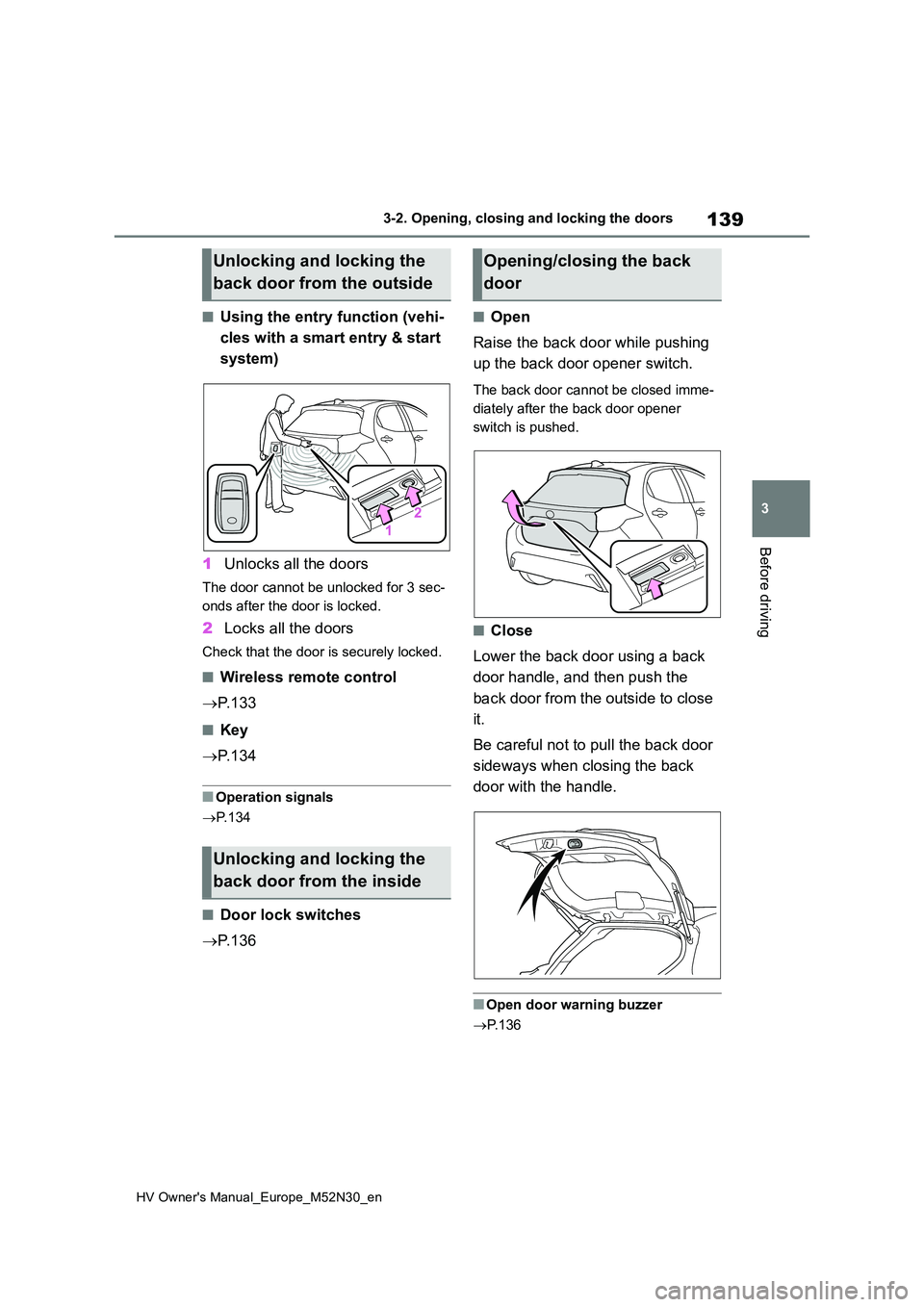
139
3
HV Owner's Manual_Europe_M52N30_en
3-2. Opening, closing and locking the doors
Before driving
■Using the entry function (vehi-
cles with a smart entry & start
system)
1 Unlocks all the doors
The door cannot be unlocked for 3 sec-
onds after the door is locked.
2 Locks all the doors
Check that the door is securely locked.
■Wireless remote control
P. 1 3 3
■Key
P. 1 3 4
■Operation signals
P. 1 3 4
■Door lock switches
P. 1 3 6
■Open
Raise the back door while pushing
up the back door opener switch.
The back door cannot be closed imme-
diately after the back door opener
switch is pushed.
■Close
Lower the back door using a back
door handle, and then push the
back door from the outside to close
it.
Be careful not to pull the back door
sideways when closing the back
door with the handle.
■Open door warning buzzer
P. 1 3 6
Unlocking and locking the
back door from the outside
Unlocking and locking the
back door from the inside
Opening/closing the back
door
Page 142 of 590
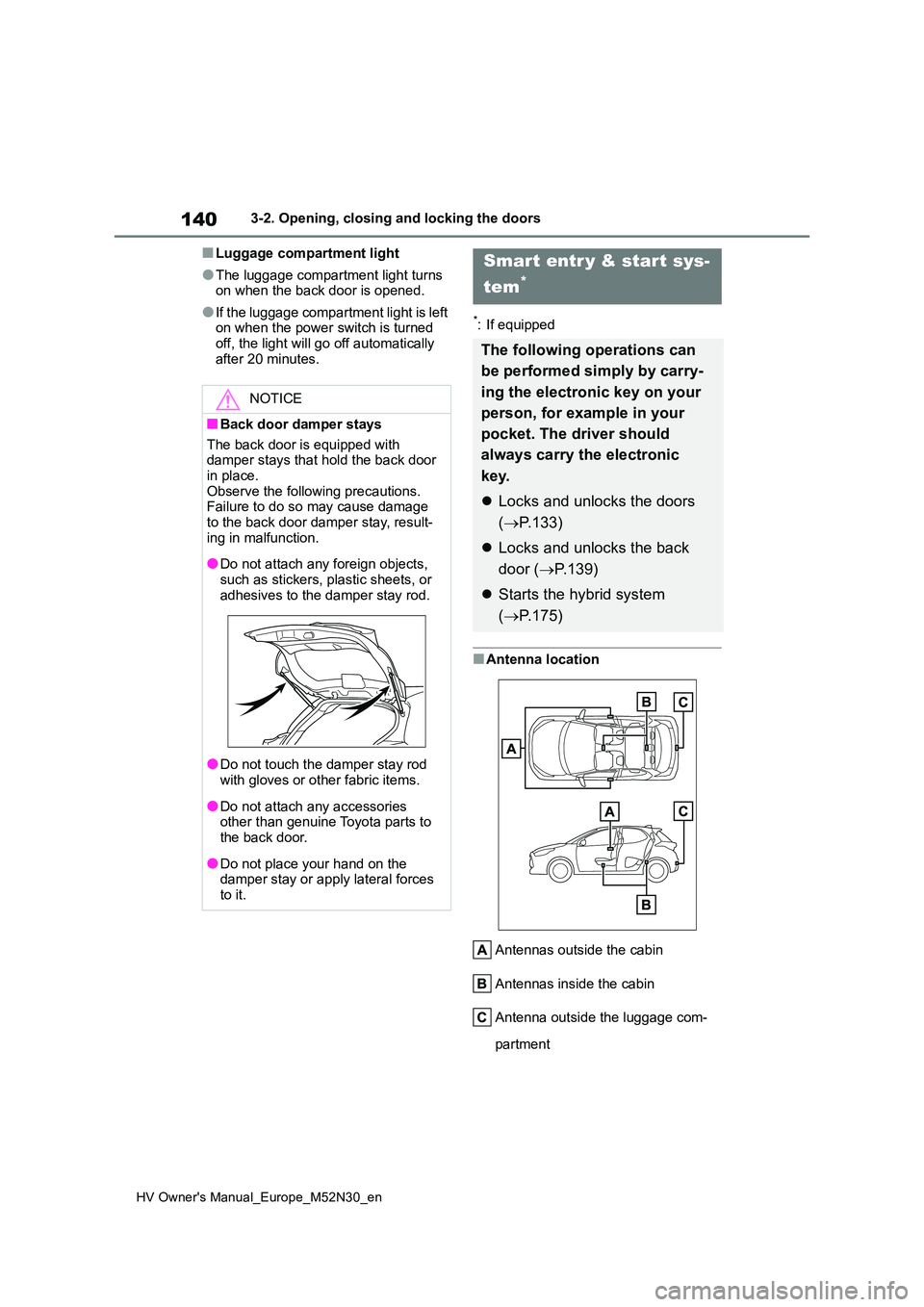
140
HV Owner's Manual_Europe_M52N30_en
3-2. Opening, closing and locking the doors
■Luggage compartment light
●The luggage compartment light turns on when the back door is opened.
●If the luggage compartment light is left on when the power switch is turned
off, the light will go off automatically after 20 minutes.
*: If equipped
■Antenna location
Antennas outside the cabin
Antennas inside the cabin
Antenna outside the luggage com-
partment
NOTICE
■Back door damper stays
The back door is equipped with damper stays that hold the back door in place.
Observe the following precautions. Failure to do so may cause damage to the back door damper stay, result-
ing in malfunction.
●Do not attach any foreign objects,
such as stickers, plastic sheets, or adhesives to the damper stay rod.
●Do not touch the damper stay rod with gloves or other fabric items.
●Do not attach any accessories other than genuine Toyota parts to the back door.
●Do not place your hand on the damper stay or apply lateral forces
to it.
Smart entr y & start sys-
tem*
The following operations can
be performed simply by carry-
ing the electronic key on your
person, for example in your
pocket. The driver should
always carry the electronic
key.
Locks and unlocks the doors
( P.133)
Locks and unlocks the back
door ( P.139)
Starts the hybrid system
( P.175)
Page 143 of 590
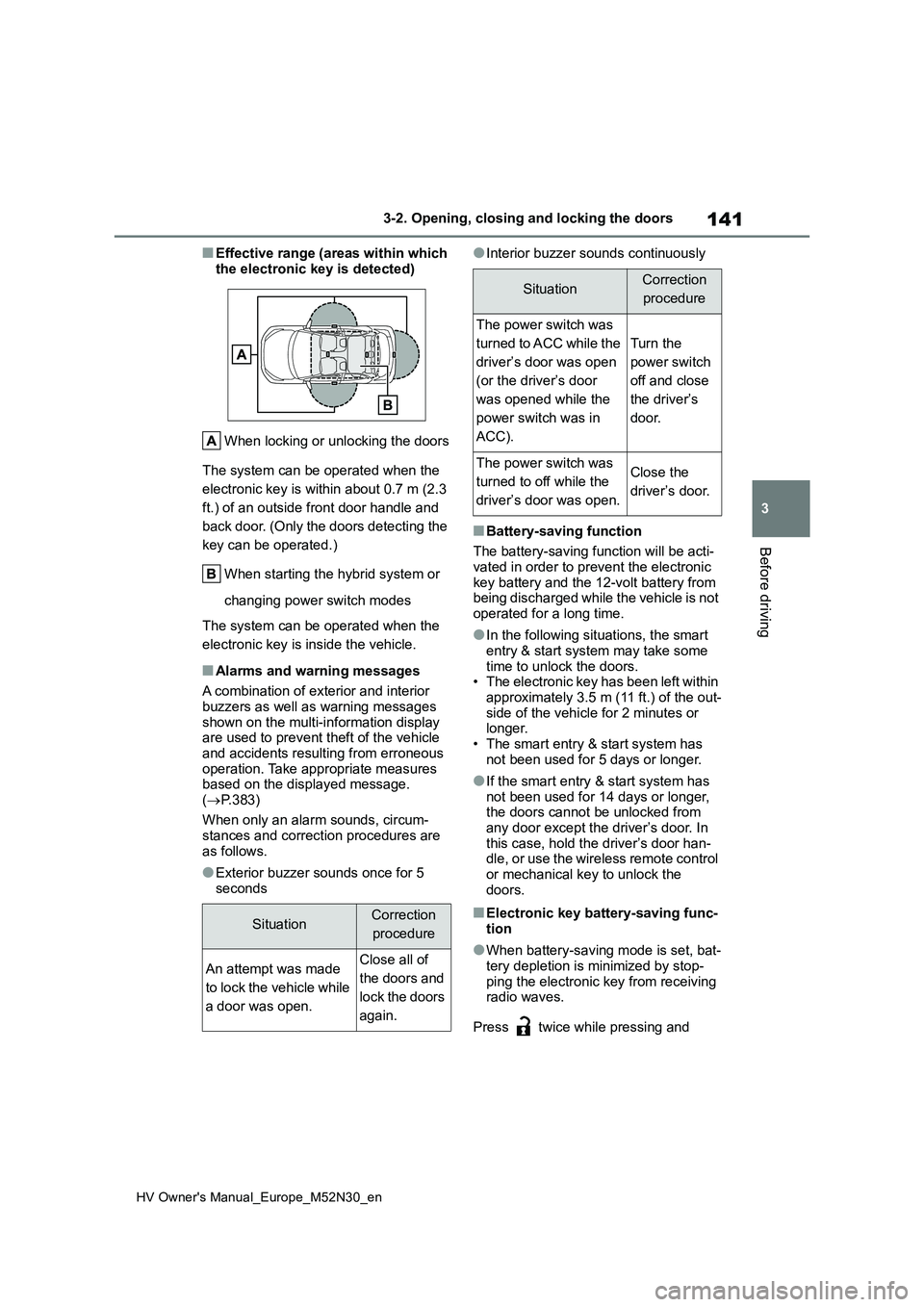
141
3
HV Owner's Manual_Europe_M52N30_en
3-2. Opening, closing and locking the doors
Before driving
■Effective range (areas within which
the electronic key is detected)
When locking or unlocking the doors
The system can be operated when the
electronic key is within about 0.7 m (2.3
ft.) of an outside front door handle and
back door. (Only the doors detecting the
key can be operated.)
When starting the hybrid system or
changing power switch modes
The system can be operated when the
electronic key is inside the vehicle.
■Alarms and warning messages
A combination of exterior and interior
buzzers as well as warning messages shown on the multi-information display are used to prevent theft of the vehicle
and accidents resulting from erroneous operation. Take appropriate measures based on the displayed message.
( P.383)
When only an alarm sounds, circum-
stances and correction procedures are as follows.
●Exterior buzzer sounds once for 5 seconds
●Interior buzzer sounds continuously
■Battery-saving function
The battery-saving function will be acti-
vated in order to prevent the electronic key battery and the 12-volt battery from being discharged while the vehicle is not
operated for a long time.
●In the following situations, the smart
entry & start system may take some time to unlock the doors.• The electronic key has been left within
approximately 3.5 m (11 ft.) of the out- side of the vehicle for 2 minutes or longer.
• The smart entry & start system has not been used for 5 days or longer.
●If the smart entry & start system has not been used for 14 days or longer, the doors cannot be unlocked from
any door except the driver’s door. In this case, hold the driver’s door han-dle, or use the wireless remote control
or mechanical key to unlock the doors.
■Electronic key battery-saving func-tion
●When battery-saving mode is set, bat-tery depletion is minimized by stop-
ping the electronic key from receiving radio waves.
Press twice while pressing and
SituationCorrection
procedure
An attempt was made
to lock the vehicle while
a door was open.
Close all of
the doors and
lock the doors
again.
SituationCorrection
procedure
The power switch was
turned to ACC while the
driver’s door was open
(or the driver’s door
was opened while the
power switch was in
ACC).
Turn the
power switch
off and close
the driver’s
door.
The power switch was
turned to off while the
driver’s door was open.
Close the
driver’s door.
Page 144 of 590
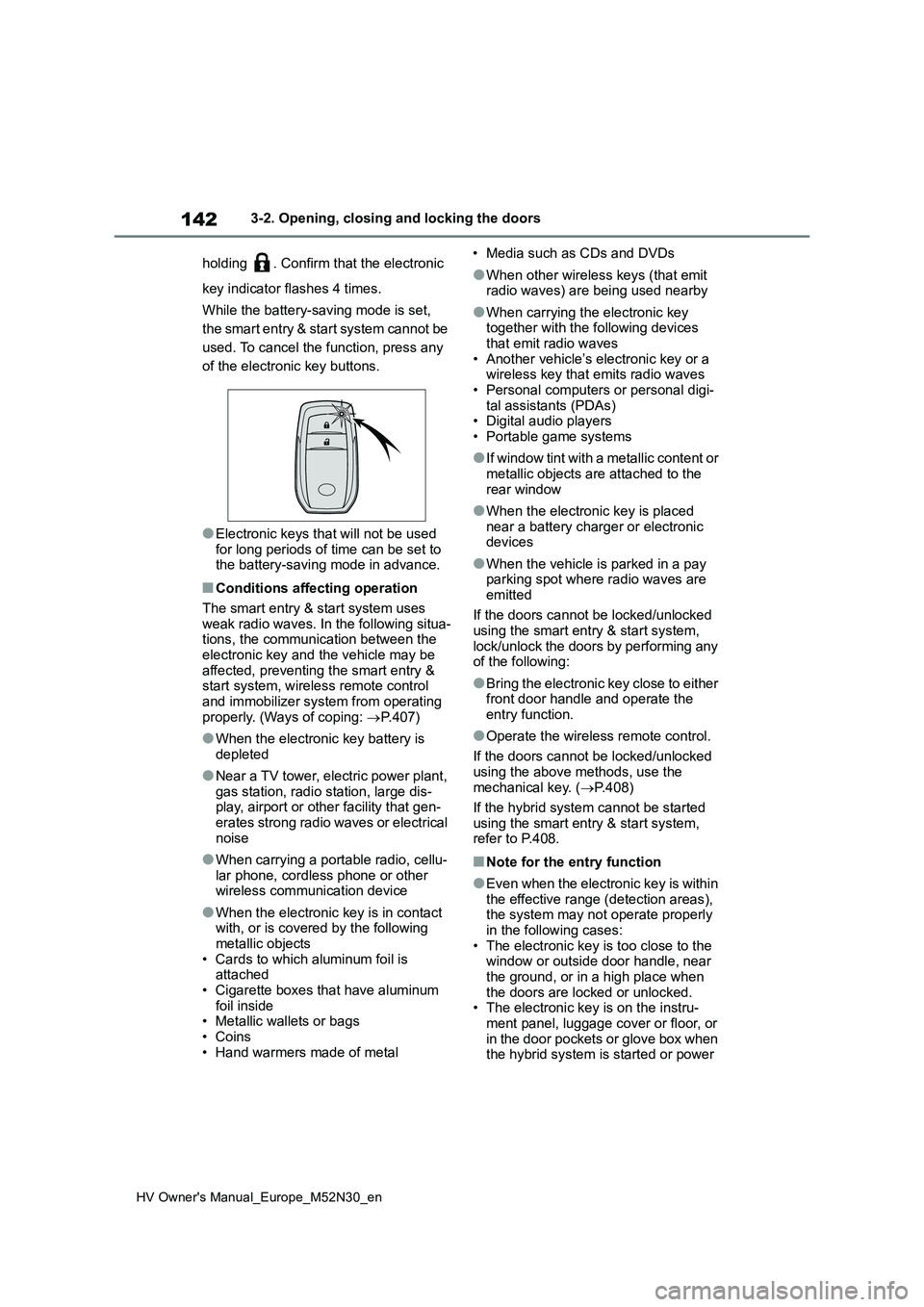
142
HV Owner's Manual_Europe_M52N30_en
3-2. Opening, closing and locking the doors
holding . Confirm that the electronic
key indicator flashes 4 times.
While the battery-saving mode is set,
the smart entry & start system cannot be
used. To cancel the function, press any
of the electronic key buttons.
●Electronic keys that will not be used for long periods of time can be set to the battery-saving mode in advance.
■Conditions affecting operation
The smart entry & start system uses weak radio waves. In the following situa-tions, the communication between the
electronic key and the vehicle may be affected, preventing the smart entry & start system, wireless remote control
and immobilizer system from operating properly. (Ways of coping: P.407)
●When the electronic key battery is depleted
●Near a TV tower, electric power plant, gas station, radio station, large dis-play, airport or other facility that gen-
erates strong radio waves or electrical noise
●When carrying a portable radio, cellu-lar phone, cordless phone or other wireless communication device
●When the electronic key is in contact with, or is covered by the following
metallic objects • Cards to which aluminum foil is attached
• Cigarette boxes that have aluminum foil inside• Metallic wallets or bags
• Coins • Hand warmers made of metal
• Media such as CDs and DVDs
●When other wireless keys (that emit radio waves) are being used nearby
●When carrying the electronic key together with the following devices
that emit radio waves • Another vehicle’s electronic key or a wireless key that emits radio waves
• Personal computers or personal digi- tal assistants (PDAs)• Digital audio players
• Portable game systems
●I f w i n d o w t i n t w i t h a m e t a l l i c c o n t e n t o r
metallic objects are attached to the rear window
●When the electronic key is placed near a battery charger or electronic devices
●When the vehicle is parked in a pay parking spot where radio waves are
emitted
If the doors cannot be locked/unlocked using the smart entry & start system,
lock/unlock the doors by performing any of the following:
●Bring the electronic key close to either front door handle and operate the entry function.
●Operate the wireless remote control.
If the doors cannot be locked/unlocked
using the above methods, use the mechanical key. ( P.408)
If the hybrid system cannot be started
using the smart entry & start system, refer to P.408.
■Note for the entry function
●Even when the electronic key is within the effective range (detection areas), the system may not operate properly
in the following cases: • The electronic key is too close to the window or outside door handle, near
the ground, or in a high place when the doors are locked or unlocked.• The electronic key is on the instru-
ment panel, luggage cover or floor, or in the door pockets or glove box when the hybrid system is started or power
Page 145 of 590
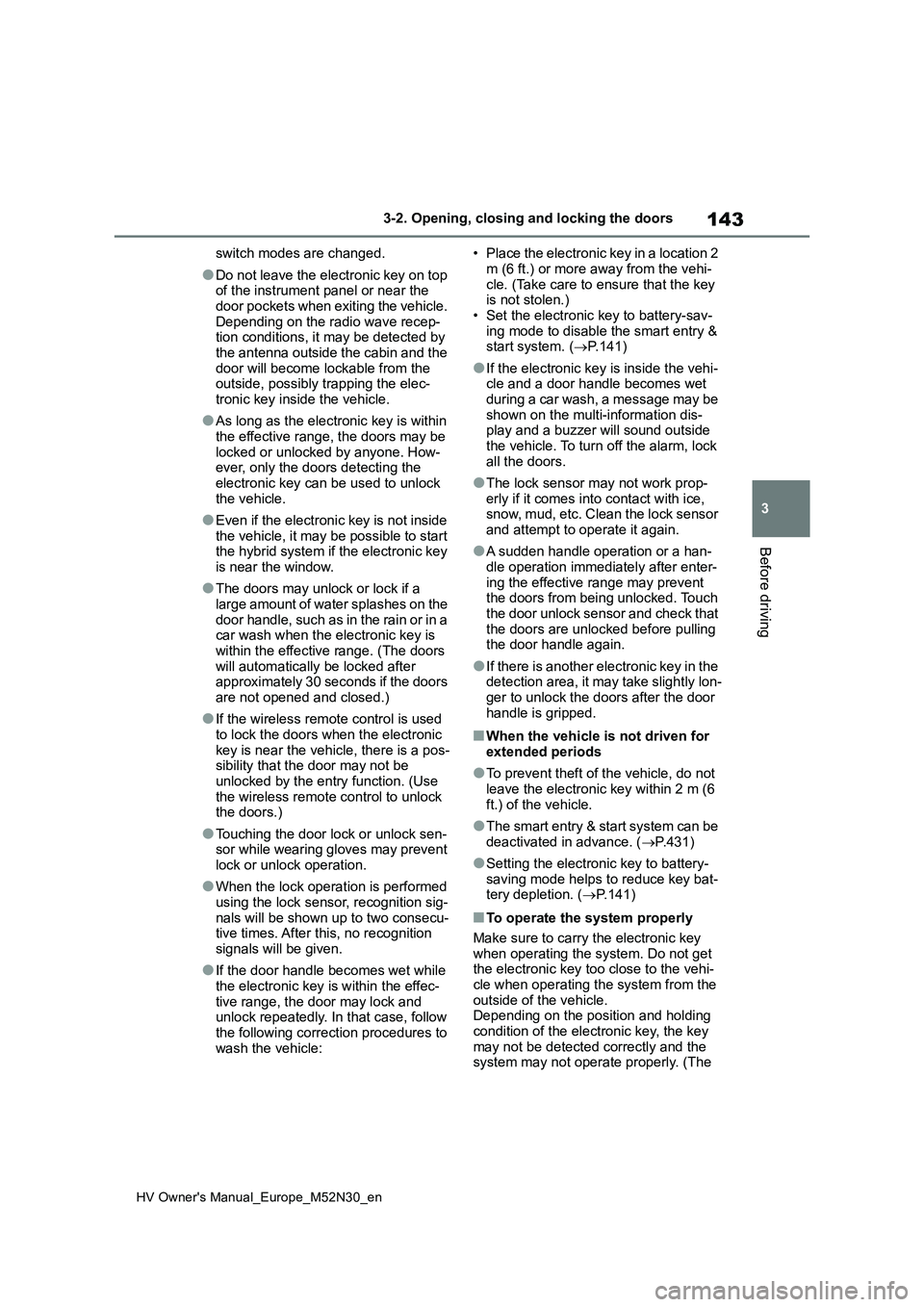
143
3
HV Owner's Manual_Europe_M52N30_en
3-2. Opening, closing and locking the doors
Before driving
switch modes are changed.
●Do not leave the electronic key on top of the instrument panel or near the
door pockets when exiting the vehicle. Depending on the radio wave recep-tion conditions, it may be detected by
the antenna outside the cabin and the door will become lockable from the outside, possibly trapping the elec-
tronic key inside the vehicle.
●As long as the electronic key is within
the effective range, the doors may be locked or unlocked by anyone. How-ever, only the doors detecting the
electronic key can be used to unlock the vehicle.
●Even if the electronic key is not inside the vehicle, it may be possible to start the hybrid system if the electronic key
is near the window.
●The doors may unlock or lock if a
large amount of water splashes on the door handle, such as in the rain or in a car wash when the electronic key is
within the effective range. (The doors will automatically be locked after approximately 30 seconds if the doors
are not opened and closed.)
●If the wireless remote control is used
to lock the doors when the electronic key is near the vehicle, there is a pos-sibility that the door may not be
unlocked by the entry function. (Use the wireless remote control to unlock the doors.)
●Touching the door lock or unlock sen-sor while wearing gloves may prevent
lock or unlock operation.
●When the lock operation is performed
using the lock sensor, recognition sig- nals will be shown up to two consecu-tive times. After this, no recognition
signals will be given.
●If the door handle becomes wet while
the electronic key is within the effec- tive range, the door may lock and unlock repeatedly. In that case, follow
the following correction procedures to wash the vehicle:
• Place the electronic key in a location 2
m (6 ft.) or more away from the vehi- cle. (Take care to ensure that the key is not stolen.)
• Set the electronic key to battery-sav- ing mode to disable the smart entry & start system. ( P.141)
●If the electronic key is inside the vehi- cle and a door handle becomes wet
during a car wash, a message may be shown on the multi-information dis-play and a buzzer will sound outside
the vehicle. To turn off the alarm, lock all the doors.
●The lock sensor may not work prop-erly if it comes into contact with ice, snow, mud, etc. Clean the lock sensor
and attempt to operate it again.
●A sudden handle operation or a han-
dle operation immediately after enter- ing the effective range may prevent the doors from being unlocked. Touch
the door unlock sensor and check that the doors are unlocked before pulling the door handle again.
●If there is another electronic key in the detection area, it may take slightly lon-
ger to unlock the doors after the door handle is gripped.
■When the vehicle is not driven for extended periods
●To prevent theft of the vehicle, do not leave the electronic key within 2 m (6
ft.) of the vehicle.
●The smart entry & start system can be
deactivated in advance. ( P.431)
●Setting the electronic key to battery-
saving mode helps to reduce key bat- tery depletion. ( P.141)
■To operate the system properly
Make sure to carry the electronic key
when operating the system. Do not get the electronic key too close to the vehi-cle when operating the system from the
outside of the vehicle. Depending on the position and holding condition of the electronic key, the key
may not be detected correctly and the system may not operate properly. (The
Page 146 of 590
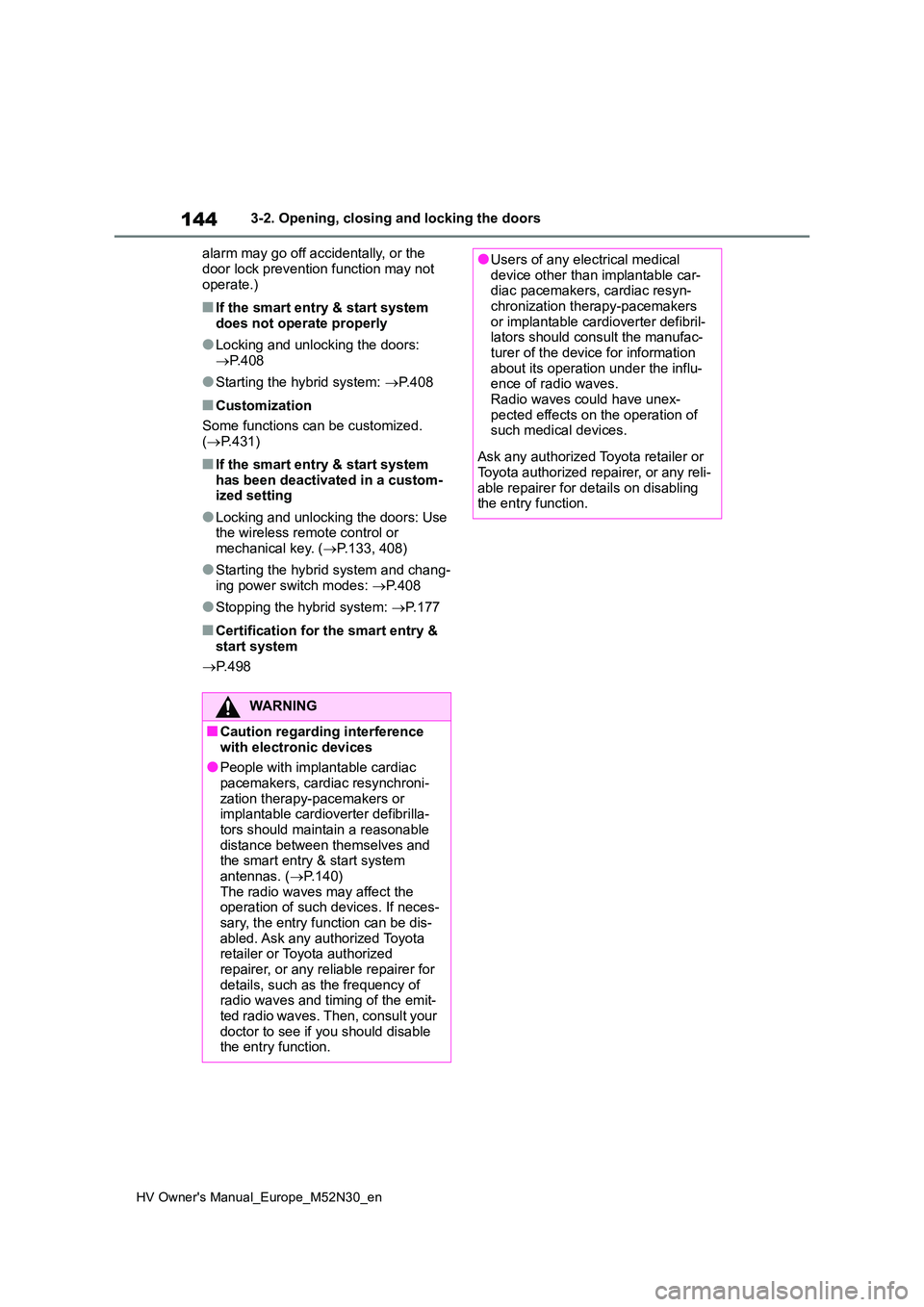
144
HV Owner's Manual_Europe_M52N30_en
3-2. Opening, closing and locking the doors
alarm may go off accidentally, or the
door lock prevention function may not operate.)
■If the smart entry & start system does not operate properly
●Locking and unlocking the doors: P. 4 0 8
●Starting the hybrid system: P.408
■Customization
Some functions can be customized.
( P.431)
■If the smart entry & start system has been deactivated in a custom-ized setting
●Locking and unlocking the doors: Use the wireless remote control or
mechanical key. ( P.133, 408)
●Starting the hybrid system and chang-
ing power switch modes: P. 4 0 8
●Stopping the hybrid system: P. 1 7 7
■Certification for the smart entry &
start system
P. 4 9 8
WARNING
■Caution regarding interference
with electronic devices
●People with implantable cardiac pacemakers, cardiac resynchroni-
zation therapy-pacemakers or implantable cardioverter defibrilla-tors should maintain a reasonable
distance between themselves and the smart entry & start system antennas. ( P.140)
The radio waves may affect the operation of such devices. If neces-sary, the entry function can be dis-
abled. Ask any authorized Toyota retailer or Toyota authorized repairer, or any reliable repairer for
details, such as the frequency of radio waves and timing of the emit-ted radio waves. Then, consult your
doctor to see if you should disable the entry function.
●Users of any electrical medical device other than implantable car-diac pacemakers, cardiac resyn-
chronization therapy-pacemakers or implantable cardioverter defibril-lators should consult the manufac-
turer of the device for information about its operation under the influ-ence of radio waves.
Radio waves could have unex- pected effects on the operation of such medical devices.
Ask any authorized Toyota retailer or Toyota authorized repairer, or any reli-
able repairer for details on disabling the entry function.
Page 147 of 590
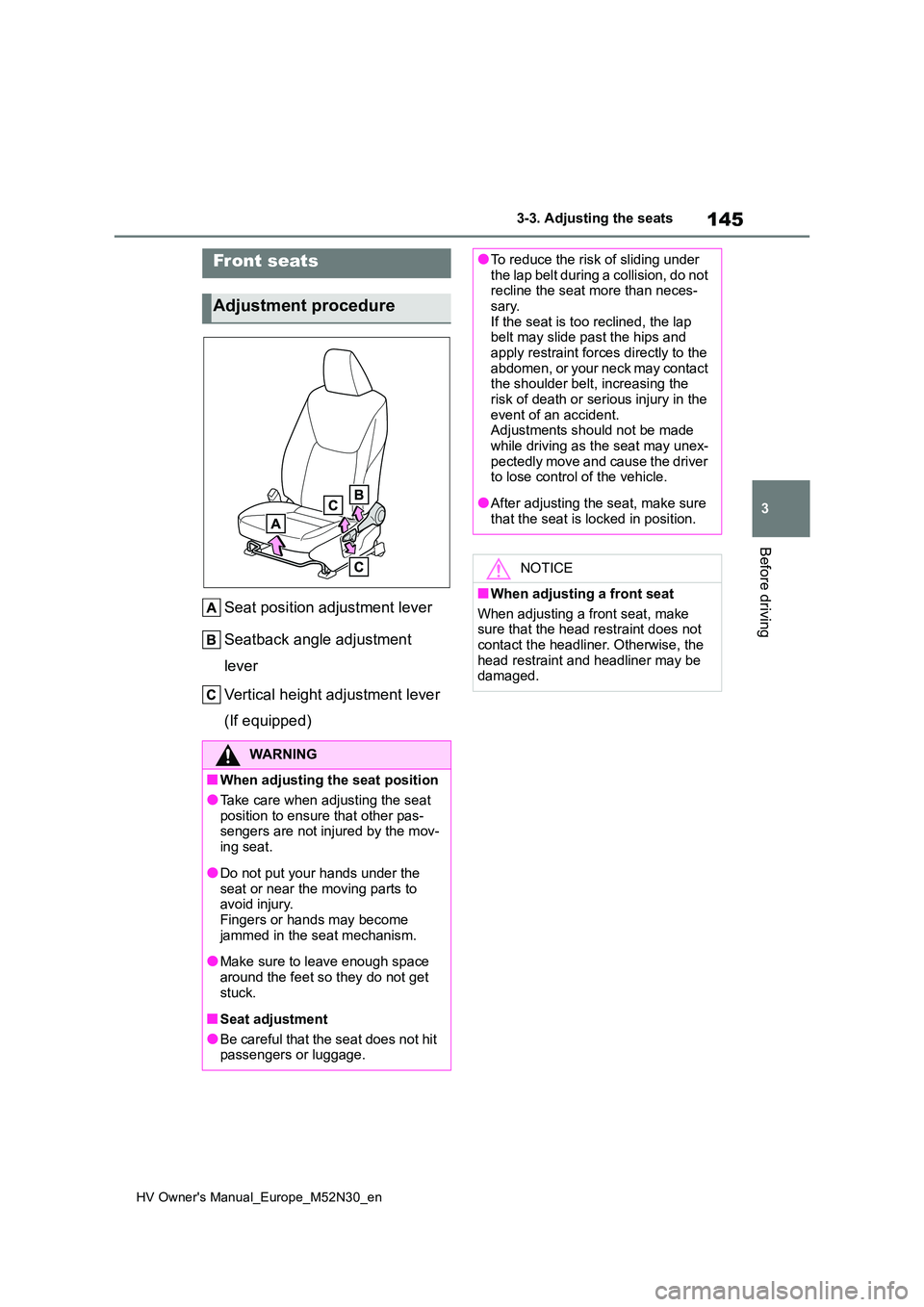
145
3
HV Owner's Manual_Europe_M52N30_en
3-3. Adjusting the seats
Before driving
3-3.Adjusting the sea ts
Seat position adjustment lever
Seatback angle adjustment
lever
Vertical height adjustment lever
(If equipped)
Front seats
Adjustment procedure
WARNING
■When adjusting the seat position
●Take care when adjusting the seat position to ensure that other pas-sengers are not injured by the mov-
ing seat.
●Do not put your hands under the
seat or near the moving parts to avoid injury.Fingers or hands may become
jammed in the seat mechanism.
●Make sure to leave enough space
around the feet so they do not get stuck.
■Seat adjustment
●Be careful that the seat does not hit passengers or luggage.
●To reduce the risk of sliding under the lap belt during a collision, do not recline the seat more than neces-
sary. If the seat is too reclined, the lap belt may slide past the hips and
apply restraint forces directly to the abdomen, or your neck may contact the shoulder belt, increasing the
risk of death or serious injury in the event of an accident.Adjustments should not be made
while driving as the seat may unex- pectedly move and cause the driver to lose control of the vehicle.
●After adjusting the seat, make sure that the seat is locked in position.
NOTICE
■When adjusting a front seat
When adjusting a front seat, make sure that the head restraint does not
contact the headliner. Otherwise, the head restraint and headliner may be damaged.
Page 148 of 590
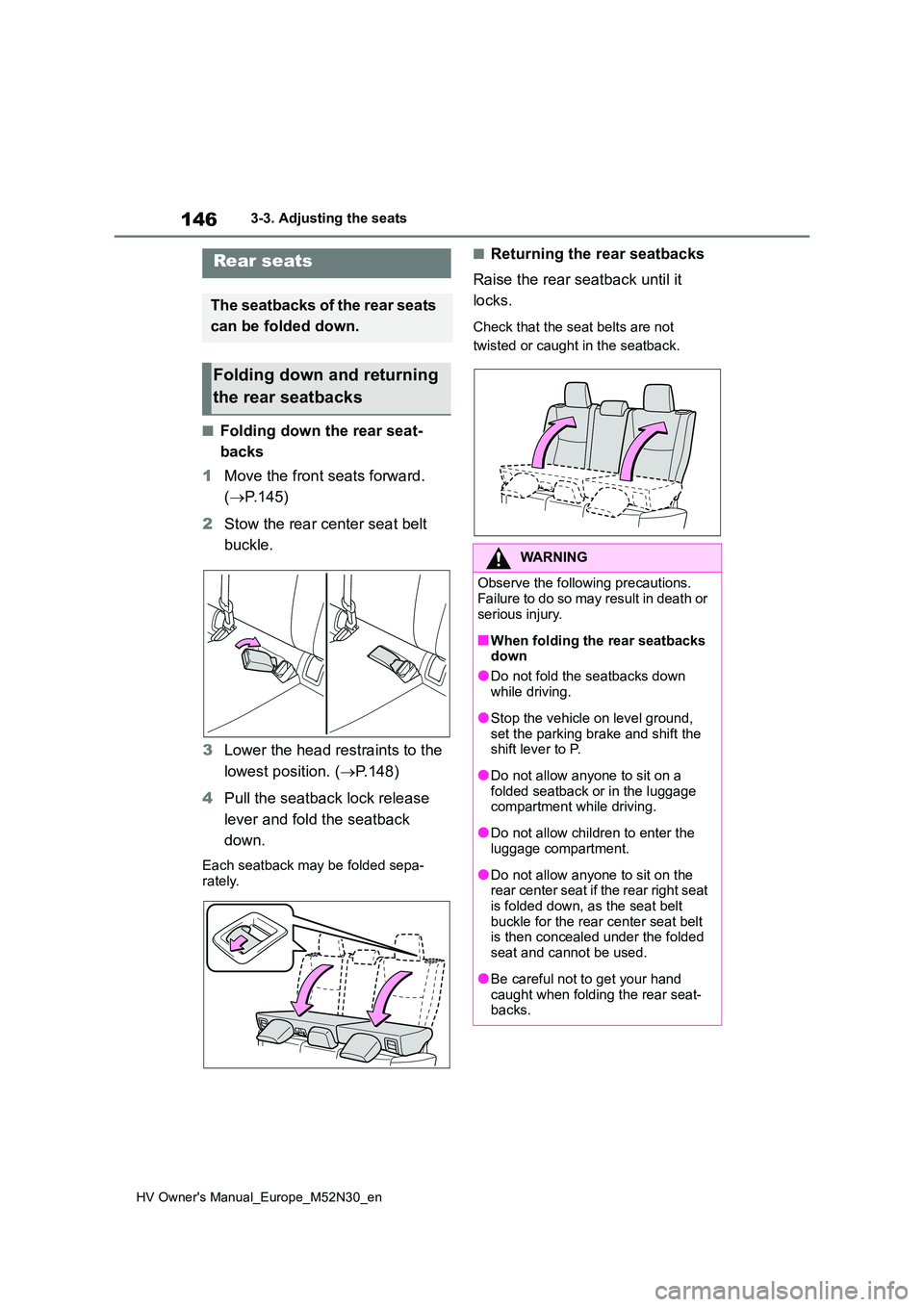
146
HV Owner's Manual_Europe_M52N30_en
3-3. Adjusting the seats
■Folding down the rear seat-
backs
1 Move the front seats forward.
( P.145)
2 Stow the rear center seat belt
buckle.
3 Lower the head restraints to the
lowest position. ( P.148)
4 Pull the seatback lock release
lever and fold the seatback
down.
Each seatback may be folded sepa-
rately.
■Returning the rear seatbacks
Raise the rear seatback until it
locks.
Check that the seat belts are not
twisted or caught in the seatback.
Rear seats
The seatbacks of the rear seats
can be folded down.
Folding down and returning
the rear seatbacks
WARNING
Observe the following precautions.
Failure to do so may result in death or serious injury.
■When folding the rear seatbacks down
●Do not fold the seatbacks down
while driving.
●Stop the vehicle on level ground,
set the parking brake and shift the shift lever to P.
●Do not allow anyone to sit on a folded seatback or in the luggage compartment while driving.
●Do not allow children to enter the luggage compartment.
●Do not allow anyone to sit on the rear center seat if the rear right seat
is folded down, as the seat belt buckle for the rear center seat belt is then concealed under the folded
seat and cannot be used.
●Be careful not to get your hand
caught when folding the rear seat- backs.
Page 149 of 590
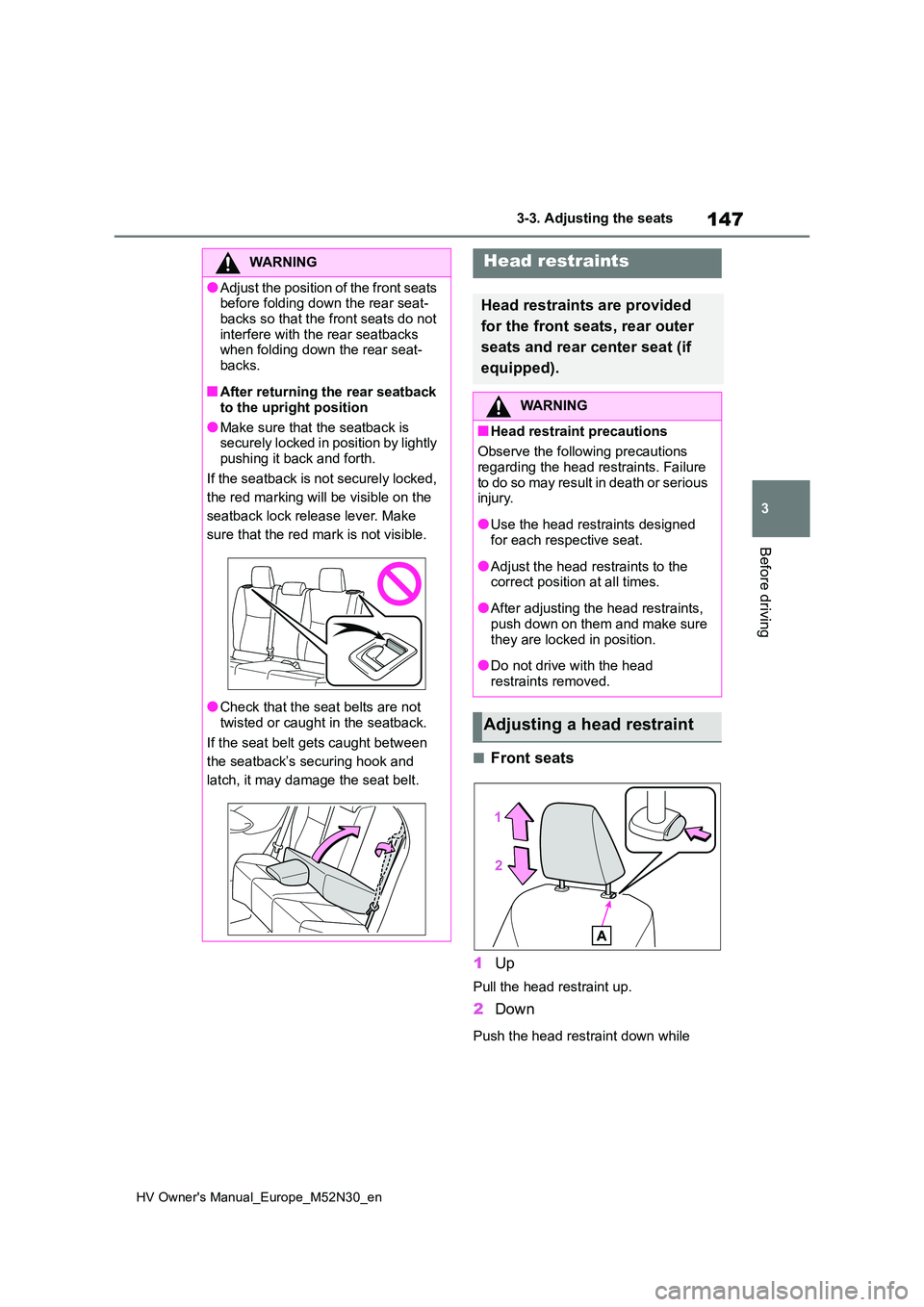
147
3
HV Owner's Manual_Europe_M52N30_en
3-3. Adjusting the seats
Before driving
■Front seats
1 Up
Pull the head restraint up.
2Down
Push the head restraint down while
WARNING
●Adjust the position of the front seats before folding down the rear seat-
backs so that the front seats do not interfere with the rear seatbacks when folding down the rear seat-
backs.
■After returning the rear seatback
to the upright position
●Make sure that the seatback is securely locked in position by lightly
pushing it back and forth.
If the seatback is not securely locked,
the red marking will be visible on the
seatback lock release lever. Make
sure that the red mark is not visible.
●Check that the seat belts are not
twisted or caught in the seatback.
If the seat belt gets caught between
the seatback’s securing hook and
latch, it may damage the seat belt.
Head restraints
Head restraints are provided
for the front seats, rear outer
seats and rear center seat (if
equipped).
WARNING
■Head restraint precautions
Observe the following precautions
regarding the head restraints. Failure to do so may result in death or serious injury.
●Use the head restraints designed for each respective seat.
●Adjust the head restraints to the correct position at all times.
●After adjusting the head restraints, push down on them and make sure
they are locked in position.
●Do not drive with the head
restraints removed.
Adjusting a head restraint
Page 150 of 590
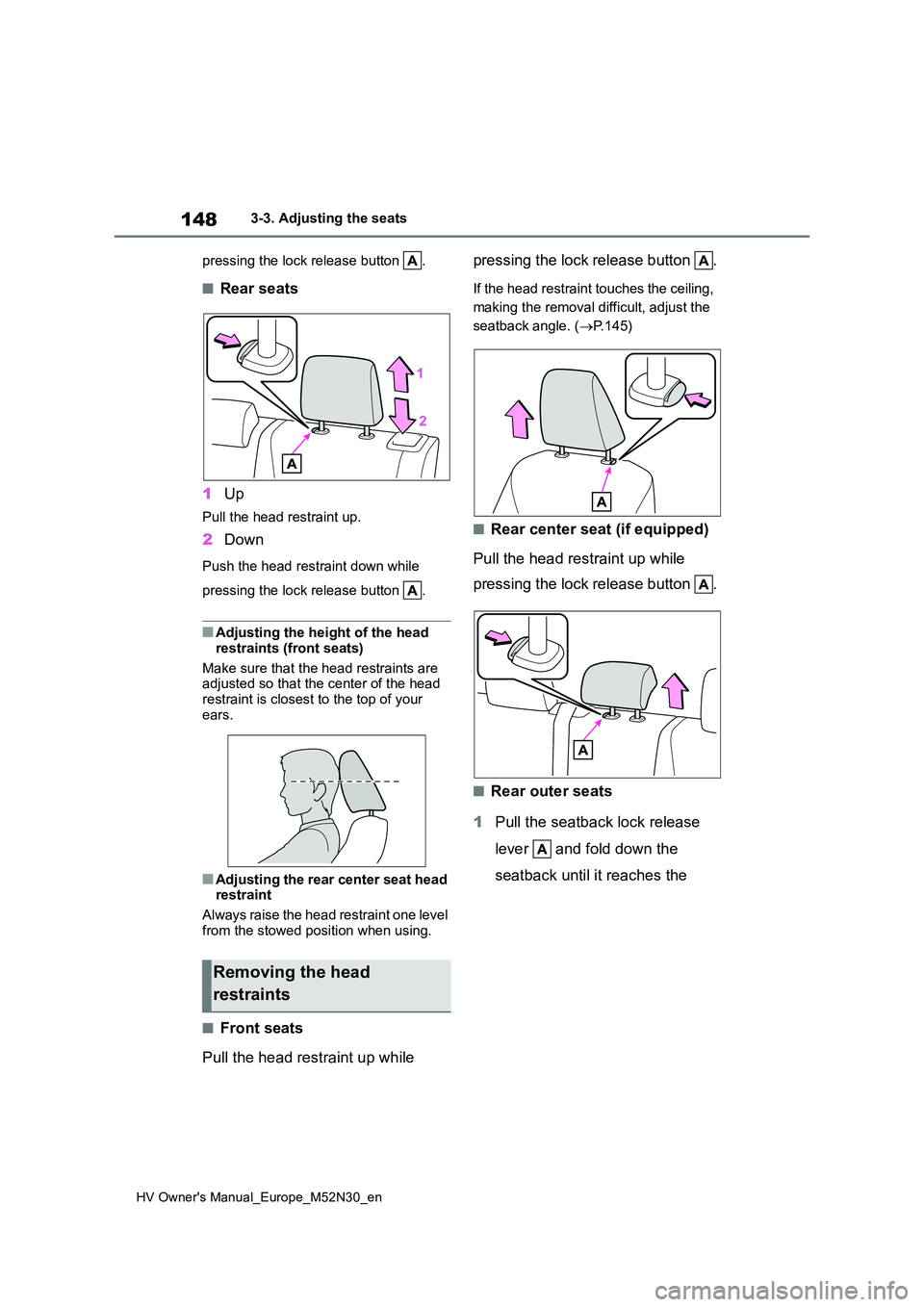
148
HV Owner's Manual_Europe_M52N30_en
3-3. Adjusting the seats
pressing the lock release button .
■Rear seats
1 Up
Pull the head restraint up.
2Down
Push the head restraint down while
pressing the lock release button .
■Adjusting the height of the head
restraints (front seats)
Make sure that the head restraints are adjusted so that the center of the head
restraint is closest to the top of your ears.
■Adjusting the rear center seat head restraint
Always raise the head restraint one level
from the stowed position when using.
■Front seats
Pull the head restraint up while
pressing the lock release button .
If the head restraint touches the ceiling,
making the removal difficult, adjust the
seatback angle. ( P.145)
■Rear center seat (if equipped)
Pull the head restraint up while
pressing the lock release button .
■Rear outer seats
1 Pull the seatback lock release
lever and fold down the
seatback until it reaches the
Removing the head
restraints